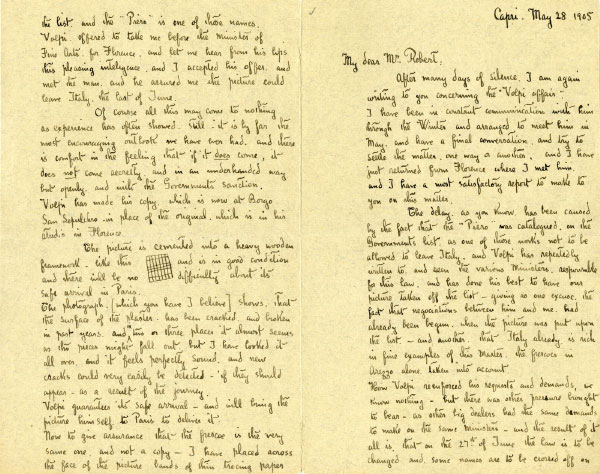Tighter international export rules made finalizing the purchase of one Italian masterpiece a Herculean effort.
The Renaissance artist, Piero della Francesca, created this image of a youthful Hercules for a wall of his own private home.
For some reason, the lower portion of the fresco was missing. But an even greater intrigue eventually surrounded this piece, one that embroiled Gardner in a scandal.
After a decade of acquisitions, Gardner's collection was already impressive. But there was always room for more.
In 1902, Isabella Stewart Gardner received a letter from her friend and advisor, artist Joseph Lindon Smith. The Florentine dealer Elia Volpi had shown him a photograph of the Hercules painting. The fresco had been detached from the wall of the artist's house and was now for sale.
Gardner had a high opinion of Joseph Lindon Smith and his eye for art; Smith was a successful painter and shared Gardner's love of travel and discovery. Having spent time in Italy, he was well positioned to help secure Hercules for her.
Taking Smith's advice, Gardner asked him to make the purchase. But matters of state halted the process: Italy changed its regulations on the sale and export of artworks. Along with many other works intended for Gilded Age collections in America and Europe, Hercules was stopped from leaving Europe.

Volpi has repeatedly written to and seen the various Ministers responsible for this law, and has done his best to have our picture taken off the list—giving as one excuse the fact that negotiations between him and me had already been begun...

The purchase finally went through at the end of 1906, but due to costly US import taxes, Hercules still remained in Europe. Gardner’s friend Emily Chadbourne offered to store the painting in her home in London, and Gardner agreed.
When Chadbourne returned to the US in 1908, she illegally imported the painting by including it with her “household goods.” This was done without Gardner's knowledge, or so she claimed.
Custom officials later discovered the undeclared artwork. The incident caused a scandal in the press, and Gardner paid a steep fine.
Bringing the painting to Boston was a Herculean effort, and one that showcased the loyalty of Gardner's friends and supporters. In the end, her “indefatigable search for art treasures” made her the first collector who managed to bring a Piero della Francesca to America.
...To your indefatigable search for art treasures we owe a great debt. Your knowledge in buying and your genius in putting together and setting each marble or picture and hanging the exquisite draperies—we shall be proud of in Boston for long years.
Your grateful fellow citizen,
Adelaide E. Wadsworth
Copyright © 2016 Isabella Stewart Gardner Museum. All rights reserved.



Premier Exhibition Sponsor: The Richard C. von Hess Foundation. The opening reception and preview are generously sponsored by Tom and Lisa Blumenthal. Exhibition support is provided by The Andrew W. Mellon Foundation and the National Endowment for Humanities. This exhibition also is supported in part by the Massachusetts Cultural Council, which receives support from the State of Massachusetts and the National Endowment for the Arts. Any viewings, findings, conclusions, or recommendations expressed in this exhibition do not necessarily represent those of the National Endowment for the Humanities. Media Sponsor: 90.9 WBUR, Boston’s NPR® News Station.